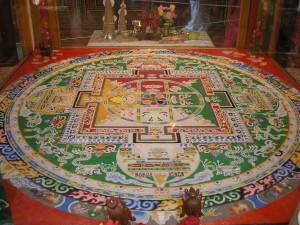Mandala of Yamantaka
Yamantaka, or Pal Dorjee Jig-Je in Tibetan, is one of the important aspects of Buddhist deity who personifies the ideal of wisdom. He can be portrayed in several different forms and one is the wrathful menifestation of Manjushri “the lord of Wisdom”.

All Buddhist teachings can be traced back to the historical Buddha, Siddhartha Gautama, who lived in India two and half thousand years ago. All the teachings are based on the Four Noble Truths the Buddha taught in the first sermon following his Enlightenment: the recognition that every living being experiences sufferings; the understanding of the
causes of this sufferings; and the path or methods by which to achieve Liberation from sufferings, or full Enlightenment.
The Buddhist Tantric teachings include methods for the purification of the psycho-physical components of human beings through meditation upon a pure being or deity, within a pure environment, or mandala. The deities who inhabit a mandala are not external gods; rather, they symbolize the Enlightened State, which everyone has the potential to realize.
Description of the Yamantaka mandala
The mandala, usually constructed from coloured sand particles on a horizontal base, depicts the residence of the thirteen deities, of whom the principal figure is Yamantaka. Although depicted here on a flat surface, like an architect’s plan, the mandala is actually a three-dimensional divine mansion.
Every aspect of the mandala has meaning; nothing is arbitrary or superfluous. The mansion is square, with four walls, each with a doorway in its centre. It rests on a green lotus, surrounded by a border of colored lotus petals. A fence of protective vajras surrounds this border. The outermost fence is of coloured flames, representing the fire of wisdom. Outside this are depicted eight great cemeteries, representing renunciation and impermanence.
The meditation
As a meditator practicing the Tantra of Yamantaka, one would familiarize oneself with every detail of the mandala and the deities within it, engaging in repeated exercises based upon visualizing the pure beings and pure environment which symbolize one’s own being and environment in purified, sublime form. Such exercises, carried out within the basic Buddhist framework of developing wisdom and compassion, bring about a profound transformation of the psyche.
Just to glimpse this sand mandala, however is thought to establish a positive connection with this profound Buddhist Tantra, and to sow positive seeds upon the mind stream of the observer which will ripen beneficially in the future as the events of our world system manifest as predicted in the Buddhist teachings.
